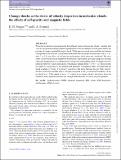Files in this item
Clumpy shocks as the driver of velocity dispersion in molecular clouds : the effects of self-gravity and magnetic fields
Item metadata
| dc.contributor.author | Forgan, D. H. | |
| dc.contributor.author | Bonnell, I. A. | |
| dc.date.accessioned | 2018-10-25T15:30:08Z | |
| dc.date.available | 2018-10-25T15:30:08Z | |
| dc.date.issued | 2018-12-21 | |
| dc.identifier | 256332258 | |
| dc.identifier | 07386a9d-1497-4890-a162-b19d81fb9732 | |
| dc.identifier | 85054717529 | |
| dc.identifier | 000454575100022 | |
| dc.identifier.citation | Forgan , D H & Bonnell , I A 2018 , ' Clumpy shocks as the driver of velocity dispersion in molecular clouds : the effects of self-gravity and magnetic fields ' , Monthly Notices of the Royal Astronomical Society , vol. 481 , no. 4 , pp. 4532-4541 . https://doi.org/10.1093/mnras/sty2580 | en |
| dc.identifier.issn | 0035-8711 | |
| dc.identifier.uri | https://hdl.handle.net/10023/16325 | |
| dc.description | DHF and IAB gratefully acknowledge support from the ECOGAL project, grant agreement 291227, funded by the European Research Council under ERC-2011-ADG. | en |
| dc.description.abstract | We revisit an alternate explanation for the turbulent nature of molecular clouds - namely, that velocity dispersions matching classical predictions of driven turbulence can be generated by the passage of clumpy material through a shock. While previous work suggested this mechanism can reproduce the observed Larson relation between velocity dispersion and size scale (σ ∝ LΓ with Γ ≈ 0.5), the effects of self-gravity and magnetic fields were not considered. We run a series of smoothed particle magnetohydrodynamics experiments, passing clumpy gas through a shock in the presence of a combination of self-gravity and magnetic fields.We find power-law relations between σ and L throughout, with indices ranging from Γ = 0.3-1.2. These results are relatively insensitive to the strength and geometry of magnetic fields, provided that the shock is relatively strong. Γ is strongly sensitive to the angle between the gas' bulk velocity, and the shock front and the shock strength (compared to the gravitational boundness of the pre-shock gas). If the origin of the σ-L relation is in clumpy shocks, deviations from the standard Larson relation constrain the strength and behaviour of shocks in spiral galaxies. | |
| dc.format.extent | 10 | |
| dc.format.extent | 2549313 | |
| dc.language.iso | eng | |
| dc.relation.ispartof | Monthly Notices of the Royal Astronomical Society | en |
| dc.subject | Hydrodynamics | en |
| dc.subject | ISM: clouds | en |
| dc.subject | ISM: kinematics and dynamic | en |
| dc.subject | ISM: structure | en |
| dc.subject | Methods: numerical | en |
| dc.subject | MHD | en |
| dc.subject | QB Astronomy | en |
| dc.subject | Astronomy and Astrophysics | en |
| dc.subject | Space and Planetary Science | en |
| dc.subject | NDAS | en |
| dc.subject.lcc | QB | en |
| dc.title | Clumpy shocks as the driver of velocity dispersion in molecular clouds : the effects of self-gravity and magnetic fields | en |
| dc.type | Journal article | en |
| dc.contributor.sponsor | European Research Council | en |
| dc.contributor.institution | University of St Andrews. School of Physics and Astronomy | en |
| dc.contributor.institution | University of St Andrews. St Andrews Centre for Exoplanet Science | en |
| dc.identifier.doi | https://doi.org/10.1093/mnras/sty2580 | |
| dc.description.status | Peer reviewed | en |
| dc.identifier.grantnumber | en |
This item appears in the following Collection(s)
Items in the St Andrews Research Repository are protected by copyright, with all rights reserved, unless otherwise indicated.

